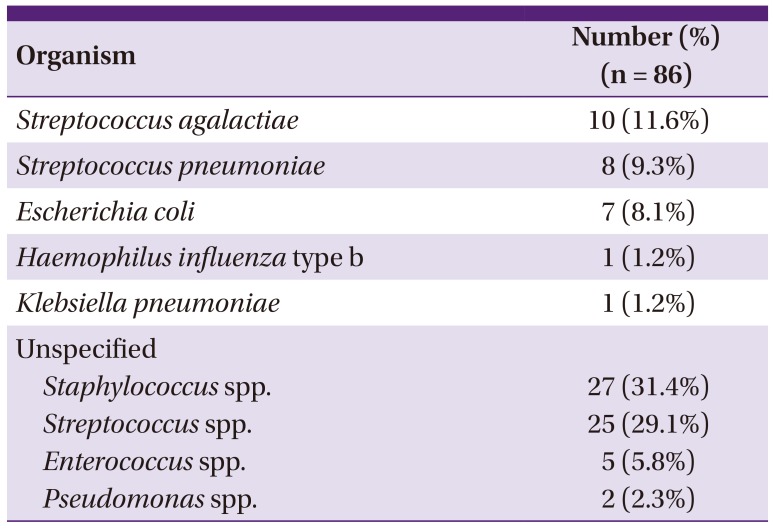1. Chávez-Bueno S, McCracken GH Jr. Bacterial meningitis in children. [vii.]. Pediatr Clin North Am. 2005; 5:795–810.

2. van de Beek D, de Gans J, Spanjaard L, Weisfelt M, Reitsma JB, Vermeulen M. Clinical features and prognostic factors in adults with bacterial meningitis. N Engl J Med. 2004; 351:1849–1859. PMID:
15509818.

3. Brouwer MC, McIntyre P, Prasad K, van de Beek D. Corticosteroids for acute bacterial meningitis. Cochrane Database Syst Rev. 2015; 12:CD004405.

4. Wubbel L, McCracken GH Jr. Management of bacterial meninigitis: 1998. Pediatr Rev. 1998; 19:78–84. PMID:
9509854.
5. Brady MT, Kaplan SL, Taber LH. Association between persistence of pneumococcal meningitis and dexamethasone administration. J Pediatr. 1981; 99:924–926. PMID:
7310585.

6. Scheld WM, Brodeur JP. Effect of methylprednisolone on entry of ampicillin and gentamicin into cerebrospinal fluid in experimental pneumococcal and
Escherichia coli meningitis. Antimicrob Agents Chemother. 1983; 23:108–112. PMID:
6338816.
7. Pfausler B, Schmutzhard E. Controversies in neurology, Vienna, 2012: steroids in bacterial meningitis. J Neural Transm (Vienna). 2013; 120:343–346. PMID:
23263539.
8. Spapen H, Van Berlaer G, Moens M, Hubloue I. Adjunctive steroid treatment in acute bacterial meningitis, “To do or not to do: that is the question. Acta Clin Belg. 2011; 66:42–45. PMID:
21485762.
9. Viladrich PF. Management of meningitis caused by resistant Streptococcus pneumoniae. In : Gillespie SH, editor. Management of multiple drug-resistance infections. Totowa, NJ: Humana Press;2004. p. 31–48.
10. Täuber MG, Moser B. Cytokines and chemokines in meningeal inflammation: biology and clinical implications. Clin Infect Dis. 1999; 28:1–11. PMID:
10028061.

11. Täuber MG, Khayam-Bashi H, Sande MA. Effects of ampicillin and corticosteroids on brain water content, cerebrospinal fluid pressure, and cerebrospinal fluid lactate levels in experimental pneumococcal meninigits. J Infect Dis. 1985; 151:528–534. PMID:
3973406.
12. Mai NT, Tuan TV, Wolbers M, Hoang DM, Nga TV, Chau TT, Chuong LV, Sinh DX, Nghia HD, Phong ND, Phu NH, Diep TS, Hang HT, Chau Nv, Farrar J, Schultsz C, Hien TT, Simmons CP. Immunological and biochemical correlates of adjunctive dexamethasone in Vietnamese adults with bacterial meningitis. Clin Infect Dis. 2009; 49:1387–1392. PMID:
19814625.

13. Gerber J, Nau R. Mechanisms of injury in bacterial meningitis. Curr Opin Neurol. 2010; 23:312–318. PMID:
20442574.

14. Esposito S, Semino M, Picciolli I, Principi N. Should corticosteroids be used in bacterial meningitis in children? Eur J Paediatr Neurol. 2013; 17:24–28. PMID:
22789668.

15. Gerber J, Tauber SC, Armbrecht I, Scchmidt H, Brück W, Nau R. Increased neuronal proliferation in human bacterial meningitis. Neurology. 2009; 73:1026–1032. PMID:
19786694.

16. Leib SL, Heimgartner C, Bifrare YD, Loeffler JM, Täauber MG. Dexamethasone aggravates hippocampal apoptosis and learning deficiency in pneumococcal meningitis in infant rates. Pediatr Res. 2003; 54:353–357. PMID:
12788989.
17. Viladrich PF, Gudiol F, Liñares J, Pallarés R, Sabaté I, Rufí G, Ariza J. Evaluation of vancomycin for therapy of adult pneumococcal meningitis. Antimicrob Agents Chemother. 1991; 35:2467–2472. PMID:
1810180.

18. París MM, Hickey SM, Uscher MI, Shelton S, Olsen KD, McCracken GH Jr. Effect of dexamethasone on therapy of experimental penicillin and cephalosporin resistant pneumococcal meningitis. Antimicrob Agents Chemother. 1994; 38:1320–1324. PMID:
8092832.
19. Cabellos C, Martinez-Lacasa J, Martos A, Tubau F, Fernández A, Viladrich PF, Gudiol F. Influence of dexamethasone on efficacy of ceftriaxone and vancomycin therapy in experimental pneumococcal meningitis. Antimicrob Agents Chemother. 1995; 39:2158–2160. PMID:
8540738.

20. Kaal EC, Vecht CJ. The management of brain edema in brain tumors. Curr Opin Oncol. 2004; 16:593–600. PMID:
15627023.

21. Lee SW, Kim WJ, Choi YK, Song HS, Son MJ, Gelman IH, Kim YJ, Kim KW. SSeCKS regulates angiogenesis and tight junction formation in blood-brain barrier. Nat Med. 2003; 9:900–906. PMID:
12808449.

22. Hori S, Ohtsuki S, Hosoya K, Nakashima E, Terasaki T. A pericyte-derived angiopoietin-1 multimeric complex induces occluding gene expression in brain capillary endothelial cells through Tie-2 activation in vitro. J Neurochem. 2004; 89:503–513. PMID:
15056293.
23. Nag S, Papneja T, Venuqopalan R, Stewart DJ. Increased angiopoietin2 expression is associated with endothelial apoptosis and blood brain barrier breakdown. Lab Invest. 2005; 85:1189–1198. PMID:
16056241.
24. Kim H, Lee JM, Park JS, Jo SA, Kim YO, Kim CW, Jo I. Dexamethasone coordinately regulates angiopoietin-1 and VEGF: a mechanism of glucocorticoid-induced stabilization of blood-brain barrier. Biochem Biophys Res Commun. 2008; 372:243–248. PMID:
18485896.

25. Fernández A, Cabellos C, Tubau F, Maiques JM, Doménech A, Ribes S, Liñares J, Viladrich PF, Gudiol F. Experimental study of teicoplanin, alone and in combination, in the therapy of cephalosporin-resistant pneumococcal meningitis. J Antimicrob Chemother. 2005; 55:78–83. PMID:
15546968.


